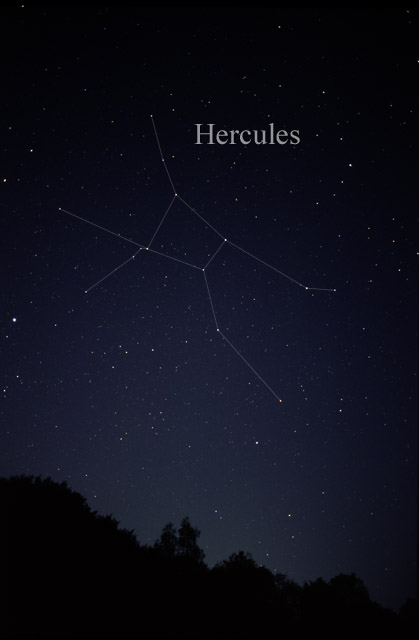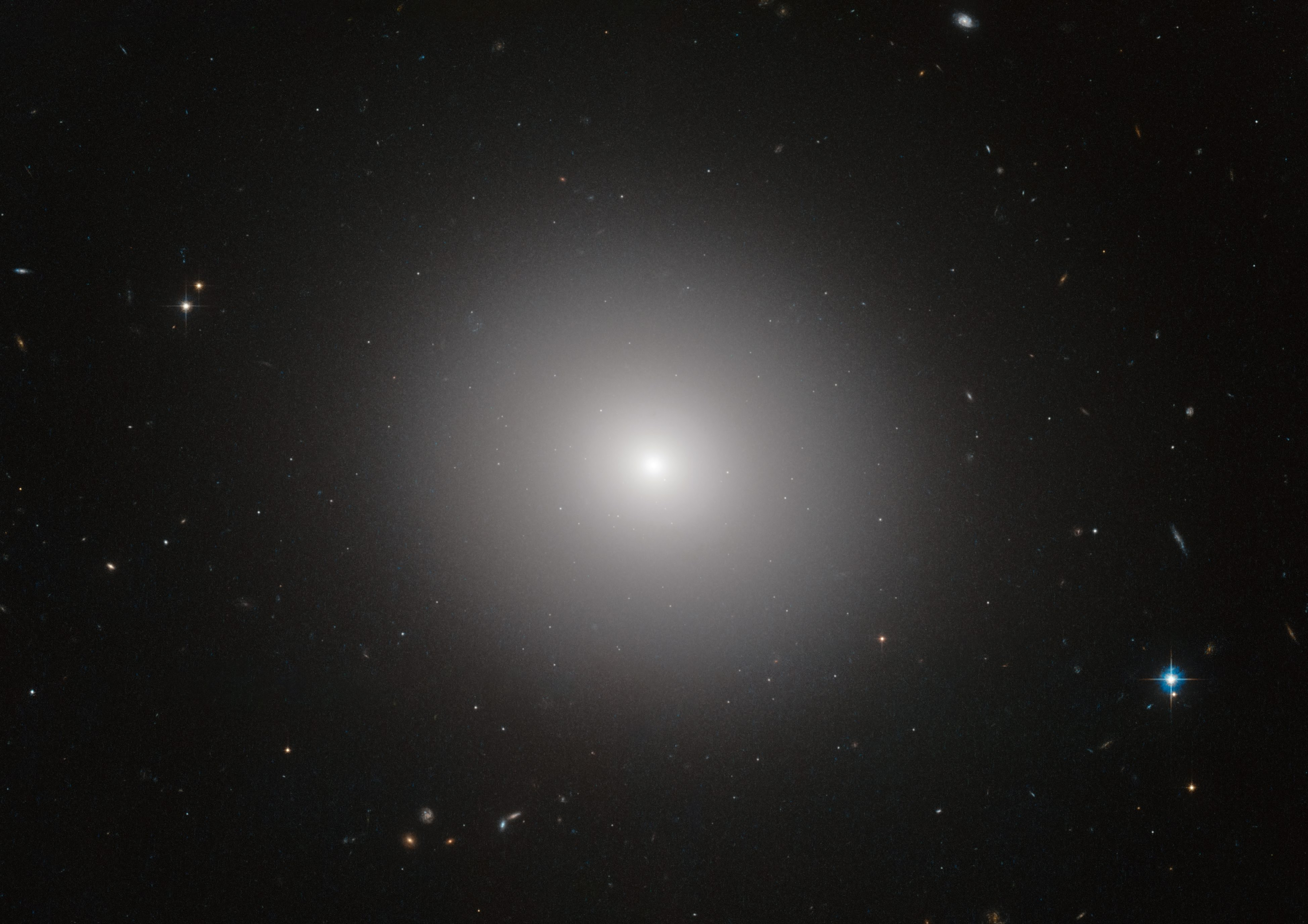|
A2261-BCG
A2261-BCG (short for Abell 2261 Brightest Cluster Galaxy) is a huge elliptical galaxy in the cluster Abell 2261. One of the largest galaxies known, A2261-BCG is estimated to have a diameter of a million light-years, some 10 times larger than the Milky Way. It is the brightest and the most massive galaxy in the cluster, and has one of the largest galactic cores ever observed, spanning more than 10,000 light-years. Yet, unusually, its center does not contain a supermassive black hole. The cD elliptical galaxy, located at least 3 billion light-years from Earth, is also well known as a radio source. Its core is highly populated by a dense number of old stars, but is mysteriously diffuse, giving it a large core. On September 10, 2012, using Hubble Space Telescope's Wide Field Camera 3, scientists realized there was no supermassive black hole A supermassive black hole (SMBH or sometimes SBH) is the largest type of black hole, with its mass being on the order of hundreds of tho ... [...More Info...] [...Related Items...] OR: [Wikipedia] [Google] [Baidu] |
Abell 2261
Abell 2261 is one of 25 galaxy clusters being studied as part of the Cluster Lensing And Supernova survey with Hubble (CLASH) program, a major project to build a library of scientific data on lensing clusters. It also has the galaxy A2261-BCG (short for Abell 2261 Brightest Cluster Galaxy) which has the one of the largest galaxy cores ever observed. In January 2021, astronomers using the Hubble Space Telescope were reported to be unable to locate a supermassive black hole presumed to be at the center of the galaxy. A newer and larger space telescope, the James Webb Space Telescope The James Webb Space Telescope (JWST) is a space telescope which conducts infrared astronomy. As the largest optical telescope in space, its high resolution and sensitivity allow it to view objects too old, distant, or faint for the Hubble Spa ..., launched in December 2021, may help determine the object's whereabouts, according to the astronomers. References Galaxy clusters {{galaxy-cl ... [...More Info...] [...Related Items...] OR: [Wikipedia] [Google] [Baidu] |
List Of Largest Galaxies
This is a list of largest galaxies known, sorted by order of increasing major axis diameters. The unit of measurement used is the light-year (approximately 9.46 kilometers). Overview Galaxies are vast collections of stars, planets, nebulae and other objects that are surrounded by an interstellar medium and held together by gravity. They do not have a definite boundary by nature, and are characterized with gradually decreasing stellar density as a function of increasing distance from its center. Because of this, measuring the sizes of galaxies can often be difficult and have a wide range of results depending on the sensitivity of the detection equipment and the methodology being used. Some galaxies emit more strongly in wavelengths outside the visible spectrum, depending on its stellar population, whose stars may emit more strongly in other wavelengths that are beyond the detection range. It is also important to consider the morphology of the galaxy when attempting to measure it ... [...More Info...] [...Related Items...] OR: [Wikipedia] [Google] [Baidu] |
Supermassive Black Hole
A supermassive black hole (SMBH or sometimes SBH) is the largest type of black hole, with its mass being on the order of hundreds of thousands, or millions to billions of times the mass of the Sun (). Black holes are a class of astronomical objects that have undergone gravitational collapse, leaving behind spheroidal regions of space from which nothing can escape, not even light. Observational evidence indicates that almost every large galaxy has a supermassive black hole at its Central massive object, center. For example, the Milky Way has a Galactic Center#Supermassive black hole, supermassive black hole in its Galactic Center, corresponding to the Astronomical radio source, radio source Sagittarius A*. Accretion (astrophysics), Accretion of Interstellar medium, interstellar gas onto supermassive black holes is the process responsible for powering Active galactic nucleus, active galactic nuclei (AGNs) and quasars. Two supermassive black holes have been directly imaged by the ... [...More Info...] [...Related Items...] OR: [Wikipedia] [Google] [Baidu] |
Epoch (astronomy)
In astronomy, an epoch or reference epoch is a moment in time used as a reference point for some time-varying astronomical quantity. It is useful for the celestial coordinates or orbital elements of a celestial body, as they are subject to perturbations and vary with time. These time-varying astronomical quantities might include, for example, the mean longitude or mean anomaly of a body, the node of its orbit relative to a reference plane, the direction of the apogee or aphelion of its orbit, or the size of the major axis of its orbit. The main use of astronomical quantities specified in this way is to calculate other relevant parameters of motion, in order to predict future positions and velocities. The applied tools of the disciplines of celestial mechanics or its subfield orbital mechanics (for predicting orbital paths and positions for bodies in motion under the gravitational effects of other bodies) can be used to generate an ephemeris, a table of values giving the posit ... [...More Info...] [...Related Items...] OR: [Wikipedia] [Google] [Baidu] |
Hercules (constellation)
Hercules is a constellation named after Hercules, the Roman mythology, Roman mythological hero adapted from the Greek mythology, Greek hero Heracles. Hercules was one of the 48 constellations listed by the second-century astronomer Ptolemy, and it remains one of the IAU designated constellations, 88 modern constellations today. It is the fifth-largest of the modern constellations and is the largest of List of brightest stars, the 50 which have no stars brighter than apparent Magnitude (astronomy), magnitude +2.5. Characteristics Hercules is bordered by Draco (constellation), Draco to the north; Boötes, Corona Borealis, and Serpens, Serpens Caput to the east; Ophiuchus to the south; Aquila (constellation), Aquila to the southwest; and Sagitta, Vulpecula, and Lyra to the west. Covering 1225.1 square degrees and 2.970% of the night sky, it ranks fifth among the 88 constellations in size. The three-letter abbreviation for the constellation, as adopted by the International Astro ... [...More Info...] [...Related Items...] OR: [Wikipedia] [Google] [Baidu] |
Brightest Cluster Galaxy
A brightest cluster galaxy (BCG) is defined as the brightest galaxy in a cluster of galaxies. BCGs include the most massive galaxies in the universe. They are generally elliptical galaxies which lie close to the geometric and kinematical center of their host galaxy cluster, hence at the bottom of the cluster potential well. They are also generally coincident with the peak of the cluster X-ray emission. Formation scenarios for BCGs include: * Cooling flow—Star formation from the central cooling flow in high density cooling centers of X-ray cluster halos. The study of accretion populations in BCGs has cast doubt over this theory and astronomers have seen no evidence of cooling flows in radiative cooling clusters. The two remaining theories exhibit healthier prospects. * Galactic cannibalism—Galaxies sink to the center of the cluster due to dynamical friction and tidal stripping. * Galactic merger—Rapid galactic mergers between several galaxies take place during cluster col ... [...More Info...] [...Related Items...] OR: [Wikipedia] [Google] [Baidu] |
Milky Way
The Milky Way is the galaxy that includes our Solar System, with the name describing the galaxy's appearance from Earth: a hazy band of light seen in the night sky formed from stars that cannot be individually distinguished by the naked eye. The term ''Milky Way'' is a translation of the Latin ', from the Greek ('), meaning "milky circle". From Earth, the Milky Way appears as a band because its disk-shaped structure is viewed from within. Galileo Galilei first resolved the band of light into individual stars with his telescope in 1610. Until the early 1920s, most astronomers thought that the Milky Way contained all the stars in the Universe. Following the 1920 Great Debate between the astronomers Harlow Shapley and Heber Curtis, observations by Edwin Hubble showed that the Milky Way is just one of many galaxies. The Milky Way is a barred spiral galaxy with an estimated D25 isophotal diameter of , but only about 1,000 light years thick at the spiral arms (more at the bulg ... [...More Info...] [...Related Items...] OR: [Wikipedia] [Google] [Baidu] |
Type-cD Galaxy
The type-cD galaxy (also cD-type galaxy, cD galaxy) is a galaxy morphology classification, a subtype of type-D giant elliptical galaxy. Characterized by a large halo of stars, they can be found near the centres of some rich galaxy clusters. They are also known as supergiant ellipticals or central dominant galaxies. Characteristics The cD-type is a classification in the Yerkes galaxy classification scheme, one of two Yerkes classifications still in common use, along with D-type. The "c" in "cD" refers to the fact that the galaxies are very large, hence the adjective supergiant, while the "D" refers to the fact that the galaxies appear diffuse. A backformation of "cD" is frequently used to indicate "central Dominant galaxy"."Uncertainties on Clusters of Galaxies Distances", C. Adami, M.P. Ulmer, 18 July 2000, (accessed 14 April 2010) cDs are also frequently considered the largest galaxies. cD galaxies are similar to lenticular galaxies (S0) or elliptical galaxies (E#), but many ... [...More Info...] [...Related Items...] OR: [Wikipedia] [Google] [Baidu] |
Hubble Space Telescope
The Hubble Space Telescope (often referred to as HST or Hubble) is a space telescope that was launched into low Earth orbit in 1990 and remains in operation. It was not the first space telescope, but it is one of the largest and most versatile, renowned both as a vital research tool and as a public relations boon for astronomy. The Hubble telescope is named after astronomer Edwin Hubble and is one of NASA's Great Observatories. The Space Telescope Science Institute (STScI) selects Hubble's targets and processes the resulting data, while the Goddard Space Flight Center (GSFC) controls the spacecraft. Hubble features a mirror, and its five main instruments observe in the ultraviolet, visible, and near-infrared regions of the electromagnetic spectrum. Hubble's orbit outside the distortion of Earth's atmosphere allows it to capture extremely high-resolution images with substantially lower background light than ground-based telescopes. It has recorded some of the most detaile ... [...More Info...] [...Related Items...] OR: [Wikipedia] [Google] [Baidu] |
Elliptical Galaxies
An elliptical galaxy is a type of galaxy with an approximately ellipsoidal shape and a smooth, nearly featureless image. They are one of the four main classes of galaxy described by Edwin Hubble in his Hubble sequence and 1936 work ''The Realm of the Nebulae'', with their intermediate scale disks, a subset of the "early-type" galaxy population. Most elliptical galaxies are composed of older, low-mass stars, with a sparse interstellar medium and minimal star formation activity, and they tend to be surrounded by large numbers of globular clusters. Elliptical galaxies are believed to make up approximately 10–15% of galaxies in the Virgo Supercluster, and they are not the dominant type of galaxy in the universe overall. They are preferentially found close to the centers of galaxy clusters. Elliptical galaxies range in size from dwarf ellipticals with tens of millions of stars, to supergiants of over one hundred trillion stars that dominate their galaxy clusters. Originally, Ed ... [...More Info...] [...Related Items...] OR: [Wikipedia] [Google] [Baidu] |





